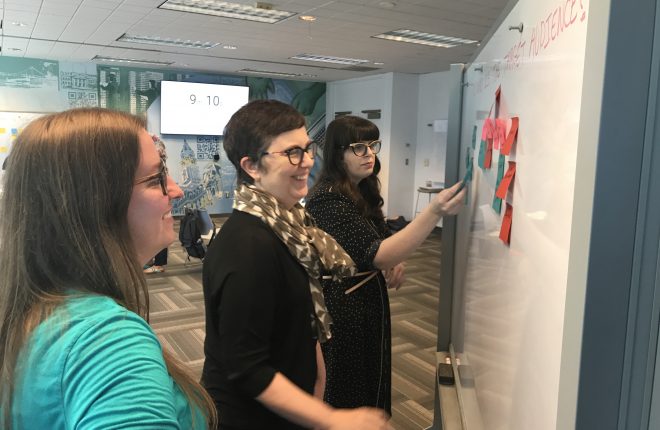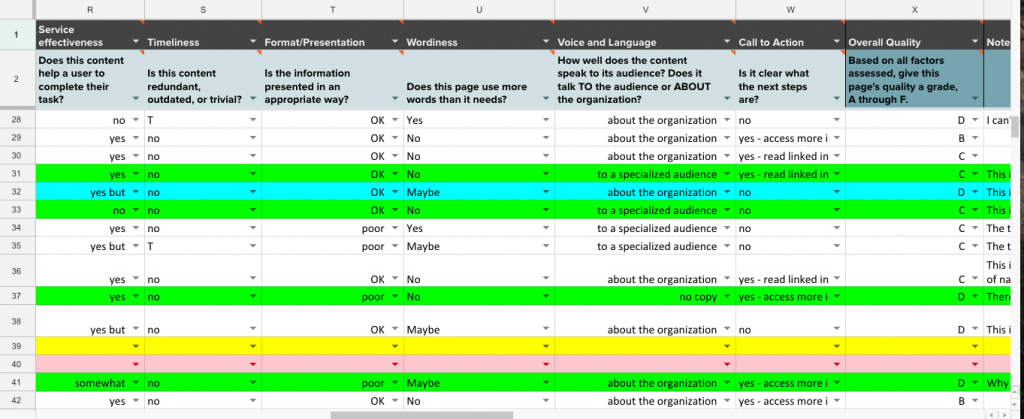If you’ve been following our blog series, you know that ODDT has brought on additional help in the form of digital transformation fellows. In our most recent post, Priya and Hanya shared the role designers can play in reshaping public sector digital services. The content design fellows were engaged in a number of projects that will help further define the new City website, but by far, the biggest project involved inventorying and auditing the content on phila.gov.
Auditing the current City website is important, because findings will help shape collaborations between ODDT and City departments as they transition legacy content to a new City website (available as a beta release) built around resident services.
What is a content inventory?
A content inventory is a meticulous accounting of a site’s content, and a critical first step in a redesign process. In fact, if you have a content-heavy site, you really can’t tackle a redesign without completing an inventory and audit first. Through the process, content strategists:
- Learn all about the site’s current state.
- Identify what content already exists — and what’s missing.
- Assess what’s redundant, outdated, and trivial (we call it a ROT analysis).
- Understand how departments use content.
- Identify services offered by departments.
- Suggest how to transfer content to a new site.
- Determine whether the content is accessible to all audiences.
How does an inventory work?
We create a spreadsheet for every department’s website where, thanks to web crawling software, we’ve collected the individual URLs associated with the department site. We open each URL to view the page and determine the quality of the contents of that page.
We then look at what the content is trying to accomplish (the goals), who it’s trying to serve (the audience), and how well it’s doing that in its current form. Our assessments are based on web writing best practices, an understanding of how people read online, the goals at hand, and editorial judgment. We record all of our findings alongside the corresponding URL in the spreadsheet.
It takes a lot of people spread out among a lot of departments to keep Philadelphia moving, and every department has representation on phila.gov. As I write this, we’ve audited a total of 7,700 pages of phila.gov. We all knew coming in that this would be a big project, but I don’t think we fully appreciated just how big.
“You really looked at 7,700 individual pages?”
Yes. Really.
There are four content design fellows working in the Office of Open Data and Digital Transformation: Arin Black, Carrie Caine, Clare Cotugno and myself, Toni McIntyre. Conducting a content inventory this big was easier because the fellows shared the work.
Because fellows don’t work within the departments we’re inventorying, we get to maintain our outsider’s point of view and interact with the information as both residents and content professionals. In the role of impartial expert, we’re able to make meaningful strategic recommendations.
What comes next
After we finish an inventory, the content team shares it with the department, along with a summary of our findings and some high-level analysis. This step is vital to building a good partnership with City departments. From there, it’s important to work with the departments on content. They are the subject-matter experts and know what content is legally required to appear on their website, or what content is part of an initiative that needs to get the most focus.
The process of sharing inventories and meeting with department leadership is ongoing and will continue after our fellowships have ended. It’s our hope that this work will help inform future collaborations between ODDT and departments throughout the City.
If the new City website is a digital doorstep, we’ve thoroughly enjoyed our time sitting on it like good Philadelphia residents, maybe with a lawn chair or two.
Coming up next: an introduction to OpenDataPhilly and the work of our fellow fellas Miguel Perez and Vito Salerno.


